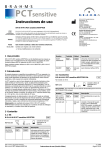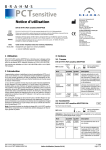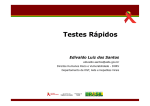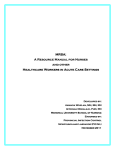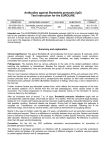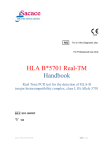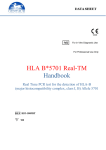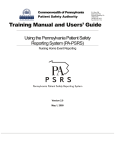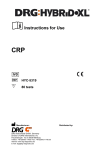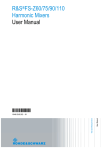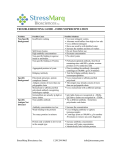Download Instruction for Use
Transcript
B·R·A·H·M·S Aktiengesellschaft Neuendorfstr. 25 16761 Hennigsdorf GERMANY Instruction for Use Switchboard phone: +49 3302 883-0 fax: +49 3302 883-100 e-mail: [email protected] B·R·A·H·M·S PCT sensitive KRYPTOR Customer Service phone: +49 3302 883-300 fax: +49 3302 883-388 e-mail: [email protected] B·R·A·H·M·S and B·R·A·H·M·S PCT are registered trademarks of B·R·A·H·M·S Aktiengesellschaft. for professional use only Other product names in this document are used for identification purposes; they may be trademarks and/or registered trademarks of their respective companies. Orders phone: +49 3302 883-600, -700, -800 fax: +49 3302 883-666 e-mail: [email protected] Protected by following patents: USA № 5 639 617; Europa № 0 656 121, № 0 880 702; Japan № 3 257 796, № 3 095 784; Australia № 686 114; China № ZL 93 1 18343X; Russia № 2 137 130; South Africa № 93/6042 TRACE products are manufactured under one or more of the following patents: EP 180492; EP 321353; EP 539477; EP 539235; EP 569496; EP 076695 Date 06.02.2008 Internet www.brahms.de www.procalcitonin.com www.kryptor.net This version supersedes all earlier versions. Changes versus previous version: ● No content changes 1 Intended Use Name B·R·A·H·M·S PCT sensitive KRYPTOR is a kit designed for B·R·A·H·M·S KRYPTOR automated immunofluorescent assays of Procalcitonin in human serum or plasma (EDTA, heparin) samples. XL665CONJUGATE Quantity Quality anti-katacalcin monoclonal mouse antibody conjugated with XL665, buffer, bovine albumin, mouse immunoglobulins, potassium fluoride. 1 These products may be used on B·R·A·H·M·S KRYPTOR and B·R·A·H·M·S KRYPTOR compact. DILUENT (4 mL) 2 Introduction The early and specific increase of Procalcitonin (PCT) in response to clinically relevant bacterial infections and sepsis represents an important laboratory diagnostic aid in the differentiation between bacterial infection and other causes of inflammatory reaction. PCT increases a couple of hours after bacterial induction, reaching levels above 0.1 ng∕mL in localised infections like LRTI (Lower Respiratory Tract Infections) and raising above 0.5 ng∕mL when infection becomes systemic. PCT levels in sepsis are generally greater than 1…2 ng∕mL and often reach values between 10 ng∕mL and 100 ng∕mL, or even higher in individual patients with severe sepsis and septic shock. As the septic infection resolves, the PCT levels also return to ranges below < 0.5 ng∕mL, with a half-life of 24 hours. Consequently, in vitro determination of PCT can be efficiently used not only for diagnosis of bacterial infection, but also to monitor the course and prognosis of clinically relevant bacterial infections and sepsis and to control the therapeutic interventions.[2][4][8] Note: The results of the B·R·A·H·M·S PCT sensitive KRYPTOR assay should always be evaluated in context of all laboratory findings and the total clinical status of the patient. 1 Description ready for use human serum, Kathon, EDTA. 3.2 Accessories B·R·A·H·M·S PCT sensitive KRYPTOR CAL Not supplied with the kit. 82591 2…8 °C see label for expiry date Intended Use: To readjust the standard curve stored by B·R·A·H·M·S KRYPTOR/KRYPTOR compact. Name Quantity B·R·A·H·M·S PCT sensitive KRYPTOR CAL bar code card Quality recombinant PCT in human serum 6 1 Description ready for use 3 Contents see the B·R·A·H·M·S KRYPTOR/ KRYPTOR compact User Manual. The bar code card contains information related to the calibrator lot including its concentration. 3.1 Kit B·R·A·H·M·S PCT sensitive KRYPTOR 825.050 50 2…8 °C B·R·A·H·M·S PCT sensitive KRYPTOR QC see label for expiry date Not supplied with the kit. 82592 Name CRYPTATECONJUGATE Quantity Quality 1 B·R·A·H·M·S Aktiengesellschaft B·R·A·H·M·S PCT sensitive KRYPTOR 2…8 °C Description anti-calcitonin sheep polyclonal antibody conjugated with europium cryptate, buffer, bovine albumin, non-immunized mice immunoglobulins, potassium fluoride. see label for expiry date Intended Use: Quality control on board of B·R·A·H·M·S KRYPTOR/KRYPTOR compact. Name B·R·A·H·M·S PCT sensitive KRYPTOR QC CONTROL 1 Instruction for Use (Version R10en) Quantity 3 Quality Description recombinant PCT in human serum D 13988 Page 1 of 6 Name Quantity B·R·A·H·M·S PCT sensitive KRYPTOR QC CONTROL 2 Quality recombinant PCT in human serum 3 bar code card 1 bar code stickon labels Description ready for use 20 for each ready for control use see the B·R·A·H·M·S KRYPTOR/ KRYPTOR compact User Manual. The bar code card contains information related to the control lot, particularly the target concentrations, the standard deviations obtained and the concentration acceptance ranges. This information is visible on the B·R·A·H·M·S KRYPTOR/KRYPTOR compact monitor screen in the quality control section. Raw materials of human origin contained in the reagents have been tested with approved kits and found negative for the antiHIV 1, anti-HIV 2, anti-HCV antibodies and the HBs antigen. However as it is impossible to strictly guarantee that such products will not transmit hepatitis, the HIV virus, or any other viral infection, all raw materials of human origin including the samples to be assayed must be treated as potentially infectious. The generally acknowledged safety precautions and laboratory techniques must be observed when handling reagents and patient samples. – Do not pipet by mouth. – Wash hands after work. – Wear protective clothing, protective gloves and safety glasses at work. The bar code stick-on labels are used for identifying the controls when assayed on B·R·A·H·M·S KRYPTOR/KRYPTOR compact. 3.3 Other requisites – Do not eat, drink or smoke in areas, where samples or kitreagents are handled. Not supplied with the kit. B·R·A·H·M·S KRYPTOR Consumables Name B·R·A·H·M·S KRYPTOR BUFFER 89970 B·R·A·H·M·S KRYPTOR SOLUTION 1 89971 B·R·A·H·M·S KRYPTOR SOLUTION 2 89972 B·R·A·H·M·S KRYPTOR SOLUTION 3 89973 B·R·A·H·M·S KRYPTOR SOLUTION 4 89974 B·R·A·H·M·S KRYPTOR DILCUP 89975 B·R·A·H·M·S KRYPTOR REACT 89976 B·R·A·H·M·S KRYPTOR compact Consumables Name B·R·A·H·M·S KRYPTOR BUFFER 89970 B·R·A·H·M·S KRYPTOR compact SOLUTION 1 89981 B·R·A·H·M·S KRYPTOR compact SOLUTION 2 89982 B·R·A·H·M·S KRYPTOR compact SOLUTION 3 89983 B·R·A·H·M·S KRYPTOR compact SOLUTION 4 89984 B·R·A·H·M·S KRYPTOR compact DILCUP 89985 B·R·A·H·M·S KRYPTOR compact REACT 89986 4 Precautions Respect the user's informations given in the User Manual of the B·R·A·H·M·S KRYPTOR/KRYPTOR compact and in this document. – – – – – Observe the expiry dates specified on the label. Reagents from different reagent kits should not be mixed. Do not dissociate the elements of an unit. Avoid any microbic contamination of the reagents. The results, obtained from this assay should always be assessed in combination with the clinical examination, patients medical history, and other findings before momentous actions will be prefaced. – Remove pollutes with absorbing paper. – All the material used for cleaning up must be disposed of as infectious laboratory waste. – Prevent from getting into sewage, water, ground. – Used reagent plates and reagent kits dispose of as potential infectious laboratory waste according to local regulations – Empty containers should be returned to local recyclers. 5 Principle The measurement principle of B·R·A·H·M·S KRYPTOR/KRYPTOR compact is based on TRACE Technology (Time-Resolved Amplified Cryptate Emission), which measures the signal that is emitted from an immunocomplex with time delay. The basis of the TRACE Technology is non-radiative energy transfer from a donor (a cage-like structure with an europium ion in the center [cryptate]) to an acceptor, which is part of a chemically modified, light-collecting algal protein (XL 665). The proximity of donor (cryptate) and acceptor (XL 665) when they are part of an immunocomplex and the spectral overlap between donor emission and acceptor absorption spectra on the one hand, intensify the fluorescent signal of the cryptate and on the other hand they extend the life span of the acceptor signal, permitting the measurement of temporally delayed fluorescence. Precise measuring of analyte concentration: When the sample is excited with a nitrogen laser at 337 nm, the donor (cryptate) emits a long-life fluorescent signal in the milli-second range at 620 nm, while the acceptor (XL 665) generates a short-life signal in the nanosecond-range at 665 nm. When the two components are bound in an immunocomplex, both the signal amplification and the prolongation of the life span of the acceptor signal occur at 665 nm, so that it can be measured over µ-seconds. This long-life signal is proportional to the concentration of the analyte to be measured. Reliable prevention of interference: Non-specific signals, e.g. the signals of the short-life and unbound acceptor XL 665 and the medium-specific interference signals conditional upon the natural fluorescence of the sample, are eliminated by temporal delay of the fluorescence measurement. The signal generated by the cryptate at 620 nm serves as an internal reference and is measured simultaneously with the long-life acceptor signal at 665 nm which is the specific signal. Interfering influences, e.g. from turbid sera, are automatically corrected by means of the internally calculated ratio of the intensities at these wavelengths. Kit contains Potassium Fluoride KF: Xn R 20/21/22, S 22-24 – Harmful by inhalation, in contact with skin and if swallowed. – Do not breathe dust. Avoid contact with skin. Avoid every splash and formation of aerosols. B·R·A·H·M·S Aktiengesellschaft B·R·A·H·M·S PCT sensitive KRYPTOR Instruction for Use (Version R10en) D 13988 Page 2 of 6 6 Instructions Sample volume ......................................... Incubation time ........................................ Results are given in.................................. Conversion factor ..................................... Direct measuring range ........................... Measuring range with automatic dilution...................................................... Sample type .............................................. Kit stability on board................................ Calibrator .................................................. Calibration stability .................................. Assay principle.......................................... 50 µL 19 min ng∕mL not applicable 0.02…50 ng∕mL 0.02…1 000 ng∕mL serum, plasma (EDTA, heparin) 14 days 1 point 7 days sandwich ● Samples that are not used in an assay within 24 hours following the drawing of a blood sample must be frozen and stored at −20 °C. ● Samples may be frozen and thawed three times[5]. ● The assay is performed directly in serum, EDTA or heparin plasma. However, the same matrix should be used for all patients during check-ups. ● Citrated plasma should not be used. ● Place the sample in a tube suited for use on B·R·A·H·M·S KRYPTOR/KRYPTOR compact (11–17 mm diameter). This might be the primary tube. ● The sample tube must contain an empty volume which will vary depending on the diameter of the sample tube. A 13 mm diameter tube will require an additional 150 µL of sample. ● Should a dilution be requested either automatically or by the user, the volume of sample necessary will be 50 µL maximum. ● Icteric, hemolytic or hyperlipemic samples, or samples which are turbid or contain fibrin may yield imprecise results. Such samples are signaled by B·R·A·H·M·S KRYPTOR/KRYPTOR compact. The operation and maintenance of B·R·A·H·M·S KRYPTOR/KRYPTOR compact are described in the related User Manual. After it has been opened the reagent unit may be stored on the B·R·A·H·M·S KRYPTOR/KRYPTOR compact in the space provided. Each reagent unit is individually identified (bar code) and its maximum period of use after opening is controlled by the instrument. ● Conjugates and sample are dispensed into the reaction plate and the signal emitted is measured periodically. ● Samples with concentrations higher than the direct measurement range, are identified in the first few minutes of incubation, then diluted automatically and reassayed. ● After measurement of the fluorescent signal, the data obtained from the software are compared to the memorized standard curve. Calibration ● Reconstitute each vial with the volume distilled water (conductivity of less than 50 µS∕cm is recommended) indicated on the vial label. ● Shake gently after reconstitution. ● Calibration must be carried out with every new reagent kit lot, it is then repeated on a regular basis automatically managed by B·R·A·H·M·S KRYPTOR/KRYPTOR compact in order to readjust the standard curve. ● Use the calibrator only once. ● Do not leave the calibrator at room temperature or on the carousel for more than 4 hours . ● The calibrator bar code card must be read in for each new lot of calibrator. ● For further information see the B·R·A·H·M·S KRYPTOR/KRYPTOR compact User Manual. Control ● It is recommended that controls be run once a day but at least after each calibration. ● A control tube is directly processed like a sample tube. ● Reconstitute each vial with the volume of distilled water (conductivity of less than 50 µS∕cm is recommended) given on the vial label. ● Allow 15 min. for the complete dissolution of the lyophilisate. ● Shake gently after reconstitution. ● After reconstitution, do not keep a vial more than 4 hours at 18…25 °C or 24 hours at 2…8 °C. ● It is recommended that the contents of a reconstituted vial be divided into aliquots which may then be stored frozen at -20 °C for a maximum period of 1 month. ● Use one of the tubes immediately for measurement. ● After thawing an aliquot, mix gently and use immediately for measurement. ● Once thawed, a control aliquot must not be refrozen. ● The bar code stick-on labels are used for identifying the controls when assayed on B·R·A·H·M·S KRYPTOR/KRYPTOR compact. ● The control kit bar code card must be entered for each new lot of control. ● For further information see the B·R·A·H·M·S KRYPTOR/KRYPTOR compact User Manual. 7 Quality Control To prepare a reagent unit, proceed as follows: – Remove the guarantee band from the box. – Push in the lid by pressing it firmly (see diagram below). Good laboratory practice requires that control samples are measured regularly to ensure the quality of the results obtained. These samples must be processed exactly the same way as the assay samples, and it is recommended that the results be analysed using appropriate statistical methods. Take care to remove all the foil. If desired, B·R·A·H·M·S KRYPTOR/KRYPTOR compact can automatically check the quality of assays at intervals, by statistical analysis on the basis of Levey Jennings graphs. It is necessary to comply with national quality assurance guidelines for quantitative tests in the medical laboratory (current version). For instance, test accuracy and precision should be monitored by means of laboratory in house and/or commercially available control materials. If unacceptable control values are obtained, proceed as outlined in standard laboratory diagnostic procedures to determine the cause and implement corrective measures. 8 Reference Range Normal Subjects: Serum or plasma PCT concentrations of healthy persons are measured with this assay as 0.064 ng∕mL (95 % percentile). Determination of normal values with another high sensitive assay revealed normal values to be below 0.05 ng∕mL.[7] Opening the Kit A standard curve does not need to be constructed on B·R·A·H·M·S KRYPTOR/ KRYPTOR compact. The instrument memorizes the required information after reading the bar code from the reagent card. A calibration must be carried out for every new reagent lot, then repeated on a regular basis. B·R·A·H·M·S KRYPTOR/KRYPTOR compact automatically indicate when a calibration is required. Both the memorized and recalibrated standard curve may be displayed on the screen. The following steps are carried out: B·R·A·H·M·S Aktiengesellschaft B·R·A·H·M·S PCT sensitive KRYPTOR Note: The cut-off may vary according to the clinical situation. PCT serum concentrations are elevated in clinically relevant bacterial infections and continue to rise with the increasing severity of the disease. However, as an expression of individually different immune responses and different clinical situations, the same focus of infection may be associated with varying individualelevations in PCT concentrations. Therefore, clinicians should use the PCT results in conjunction with the patient’s other laboratory findings and clinical signs, and interpret the concrete values in the context of the patient’s clinical situation. The reference ranges are therefore given for orientational purpose only. Instruction for Use (Version R10en) D 13988 Page 3 of 6 Differential diagnosis of Lower Respiratory Tract Infections See data of Christ-Crain et al.[8] ng∕mL PCT Analysis < 0.1 Indicates absence of bacterial infection. Use of antibiotics strongly discouraged, also in the presence of impaired pulmonary reserve in AECOPD 0.1 to < 0.25 Bacterial infection unlikely. The use of antibiotics is discouraged 0.25 to < 0.5 Bacterial infection is possible. Advice to initiate antimicrobial therapy > 0.5 Suggestive of the presence of bacterial infection. Antibiotic treatment strongly recommended Diagnosis of systemic bacterial infection/ sepsis[1][2] [3] SIRS, Sepsis, Severe Sepsis, and Septic Shock were categorised according to the criteria of the consensus conference of the American College of Chest Physicians/Society of Critical Care Medicine.[6] Analysis < 0.5 Local bacterial infection is possible. The detection limit, calculated using the imprecision profile, has been assessed as being 0.02 ng∕mL with a probability of 95 %. Sensitivity The functional assay sensitivity, detected by inter-assay precision of 20 % CV has been assessed as being 0.06 ng∕mL. Specificity The antibodies used in this assay show no cross-reaction with human calcitonin (up to 3.9 ng∕mL), human katacalcin (up to 22.5 ng∕mL), human a-CGRP and b-CGRP (up to 30 ng∕mL). Accuracy/ Linearity Accuracy/ "High Dose Hook" Effect Low risk for progression to severe systemic infection (severe sepsis)[6]. No High Dose Hook up to 5 000 ng∕mL. Systemic infection (sepsis) is possible, but various conditions are known to induce PCT as well (see below). Moderate risk for progression to severe systemic infection (severe sepsis)[6]. Precision/ Reproducibility for Intra Assay CV Precision is estimated in accordance with CLSI guideline EP5-A (Evaluation of Precision Performance of Clinical Chemistry Devices). Sample/Conc. Intra-Assay-CV ~ 0.1 ng∕mL ~ 15 % ~ 0.2 ng∕mL ~ 10 % > 0.3 ng∕mL <5% Precision/ Reproducibility for Inter Assay CV Precision is estimated in accordance with CLSI guideline EP5-A (Evaluation of Precision Performance of Clinical Chemistry Devices). Sample/Conc. Inter-Assay-CV The patient should be closely monitored both clinically and by re-assessing PCT within 6…24 hours. ~ 0.1 ng∕mL ~ 15 % ~ 0.2 ng∕mL ~ 10 % Systemic infection (sepsis) is likely, unless other causes are known. > 0.3 ng∕mL <6% High risk for progression to severe systemic infection (severe sepsis)[6]. > 10 Detection Limit Systemic infection (sepsis)[6] is not likely. ● PCT levels below 0.5 ng∕mL do not exclude an infection, because localised infections (without systemic signs) may be associated with such low levels. ● Also if the PCT measurement is done very early after following bacterial challenge (usually < 6 hours), these values may still be low. In this case, PCT should be re-assessed 6…24 hours later.[4] > 2 and < 10 9 Assay Performance Dilution of highly concentrated samples revealed recovery rates between 80 % and 120 %. ng∕mL PCT > 0.5 and < 2 Such low levels may be obtained, e.g., during the early course of infections, in localized infections and in subacute endocarditis. Therefore, follow-up and re-evaluation of PCT in clinical suspicion of infection is pivotal. The PCT measuring technique should be chosen dependent on intended clinical use. Disturbing Factors Important systemic inflammatory response, almost exclusively due to severe bacterial sepsis or septic shock Factor Description Hemoglobin no significant effect up to 500 mg∕dL High likelihood of severe sepsis or septic shock[6] Bilirubin no significant effect up to 40 mg∕dL Triglycerides no significant effect up to 22.5 mg∕mL Note: Increased PCT levels may not always be related to infection. There are a few situations described where PCT can be elevated by non-infectious causes. These include, but are not limited to ● neonates < 48 hours of life (physiological elevation) ● the first days after a major trauma, major surgical intervention, severe burns, treatment with OKT3 antibodies and other drugs stimulating the release of pro-inflammatory cytokines ● patients with invasive fungal infections, acute attacks of plasmodium falciparum malaria ● patients with prolonged or severe cardiogenic shock, prolonged severe organ perfusion anomalies, small cell lung cancer, medullary C-cell carcinoma of the thyroid. Low PCT levels do not automatically exclude the presence of bacterial infection. B·R·A·H·M·S Aktiengesellschaft B·R·A·H·M·S PCT sensitive KRYPTOR Traceability An International PCT- Reference Preparation is not available. Therefore PCTAssays are calibrated using a reference preparation antigen as master calibrator. This highest available standard is specified by B·R·A·H·M·S with 1. N-terminal amino acid sequencing (edmanns method) and 2. Mass analysis Dilutions of master calibrator are checked by regression analysis and accepted with a max. deviation of 5 % compared to theoretical expected results. Quality Control of new calibrator manufacturing ensures reproducibility and stability of calibration along time (according B·R·A·H·M·S SOP). Instruction for Use (Version R10en) D 13988 Page 4 of 6 10 Bibliography [7] [8] [9] Analyte [1] [2] [3] [4] [5] [6] Müller B. et al., Crit. Care Med. 2000, 28(4): 977–983. Harbarth S. et al., Am. J. Resp. Crit. Care Med. 2001, 164: 396–402. Brunkhorst F.M. et al., Intensive Care Med. 2000, 26 (suppl.2): 148–152. Meisner M, Thieme Stuttgart, New York 2000, ISBN: 3-13-105503-0 Meisner M. et al., Eur J Clin Chem Clin Biochem 1997; 35 (8): 597–601. American College of Chest Physicians/Society of Critical Care Medicine (1992), Crit Care Med 20: 864–874. Morgenthaler N. et al., Clin Lab. 2002;48(5-6): 263–270. Christ-Crain M. et al., Lancet. 2004,363(9409): 600–607. Chiesa C. et al., Clin. Infect. Dis. 1998, 26: 664–672. Technology [A] [B] [C] [D] Mathis G, Lehn JM.: Trace – Another Story of Time. Isotopics 1995; Vol. 9. Mathis G. , Clin. Chem. 1993; 39:1953-9. B·R·A·H·M·S KRYPTOR/KRYPTOR compact User Manual. B·R·A·H·M·S KRYPTOR/KRYPTOR compact Manual. 11 Symbols Symbols used in Instruction for Use and Product Labelling of B·R·A·H·M·S KRYPTOR products. Symbol Usage Symbol Usage Symbol Usage Reference to the Intended use of the Medical Device In Vitro Diagnostic Medical Device Batch Code Contents Calibrator Control Buffer B·R·A·H·M·S KRYPTOR SOLUTION 1/ B·R·A·H·M·S KRYPTOR compact SOLUTION 1 B·R·A·H·M·S KRYPTOR SOLUTION 2/ B·R·A·H·M·S KRYPTOR compact SOLUTION 2 B·R·A·H·M·S KRYPTOR SOLUTION 3/ B·R·A·H·M·S KRYPTOR compact SOLUTION 3 B·R·A·H·M·S KRYPTOR SOLUTION 4/ B·R·A·H·M·S KRYPTOR compact SOLUTION 4 Bags contained Bags Plates contained Plates Vials contained Vials Vial Use given Volume of destilled Water (conductivity of less than 50 µS∕cm is recommended) for Reconstitution, e.g. 0.75 mL Lyophilized, Freeze Dried Reconstitute Name and Address of Manufacturer Use by Green Dot according to German Law Registered Trade Mark Article Number/Catalogue Number Contains sufficient for (Number of) tests, e.g. 50 Consult Instruction for Use See Accompanying Compact Disk Biohazard Wear Protective Gloves Wear Safety Glasses Wash hands General Regulatory Sign General Prohibitive Sign Do not Smoke Do not Eat and Drink Harmful Irritant Trade Mark for TRACE-technology CE Conformity Marking According to Directive 98/79/EC on In Vitro Diagnostic Medical Devices CE Conformity Marking According to Directive 98/79/EC on In Vitro Diagnostic Medical Devices, Annex II with Reg.Number of Notified Body Temperature Limitation Do not Reuse Caution / Take Notice / Consult Accompanying Documents Accidental Release Measures Waste B·R·A·H·M·S Aktiengesellschaft B·R·A·H·M·S PCT sensitive KRYPTOR Instruction for Use (Version R10en) D 13988 Page 5 of 6 THIS PRODUCT IS SUBJECT TO PROPRIETARY RIGHTS OF GE HEALTHCARE BIO-SCIENCES CORP. (“GE HEALTHCARE”) AND CARNEGIE MELLON UNIVERSITY (“CARNEGIE MELLON”) AND MADE AND SOLD UNDER LICENSE FROM GE HEALTHCARE. THE PRODUCT BEARING THIS LABEL IS LICENSED FOR SALE ONLY FOR RESEARCH (NOT TO INCLUDE IN VIVO RESEARCH) AND IN VITRO DIAGNOSTIC USE AND IN ADDITION MAY BE USED TO PERFORM IN VITRO DIAGNOSTIC SERVICES FOR THIRD PARTIES. IT IS NOT LICENSED NOR ARE THERE ANY IMPLIED LICENSES FOR ANY OTHER USE INCLUDING, WITHOUT LIMITATION, COMMERCIAL USES UNLESS EXPRESSLY AUTHORIZED BY GE HEALTHCARE IN WRITING. IF YOU INTEND TO USE THIS PRODUCT COMMERCIALLY AND YOU DO NOT HAVE A LICENSE TO USE THIS PRODUCT FOR THE INTENDED COMMERCIAL PURPOSE, RETURN THIS PRODUCT, UNOPENED TO BRAHMS AKTIENGESELLSCHAFT, NEUENDORFSTR. 25, D-16761 HENNIGSDORF/BERLIN, GERMANY AND ANY MONEY PAID FOR THE PRODUCT WILL BE REFUNDED. PURPOSE, OR MERCHANTABILITY, EXCLUSIVITY OR RESULTS OBTAINED FROM USE OF THIS PRODUCT, NOR SHALL GE HEALTHCARE OR CARNEGIE MELLON BE LIABLE FOR DIRECT, INDIRECT, SPECIAL, OR CONSEQUENTIAL DAMAGES SUCH AS LOSS OF PROFITS OR INABILITY TO USE SAID INTELLECTUAL PROPERTY OR ANY APPLICATIONS AND DERIVATION THEREOF. GE HEALTHCARE AND/OR CARNEGIE MELLON DOES NOT MAKE ANY WARRANTY OF ANY KIND WITH RESPECT TO FREEDOM FROM PATENT, TRADEMARK, OR COPYRIGHT INFRINGEMENT, OR THEFT OF TRADE SECRETS AND DOES NOT ASSUME ANY LIABILITY HEREUNDER FOR ANY INFRINGEMENT OF ANY PATENT, TRADEMARK, OR COPYRIGHT ARISING FROM THE USE OF THE PRODUCT. IF YOU ARE USING THIS PRODUCT FOR COMMERCIAL IN VITRO DIAGNOSTIC SERVICES, YOU AGREE THAT YOU WILL NOT MAKE ANY WARRANTY ON BEHALF OF GE HEALTHCARE OR CARNEGIE MELLON, EXPRESSED OR IMPLIED, TO ANY PERSON CONCERNING THE APPLICATION OF OR THE RESULTS TO BE OBTAINED WITH THE PRODUCT. UNLESS OTHERWISE AGREED IN WRITING, GE HEALTHCARE AND/OR CARNEGIE MELLON MAKES NO WARRANTIES OF ANY KIND, EITHER EXPRESSED OR IMPLIED AS TO ANY MATTER INCLUDING, BUT NOT LIMITED TO, WARRANTY OF FITNESS FOR B·R·A·H·M·S Aktiengesellschaft B·R·A·H·M·S PCT sensitive KRYPTOR Instruction for Use (Version R10en) D 13988 Page 6 of 6






